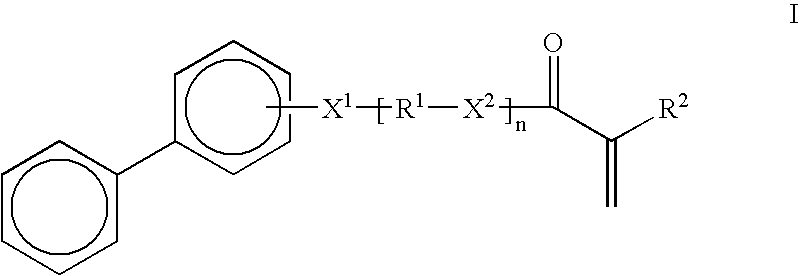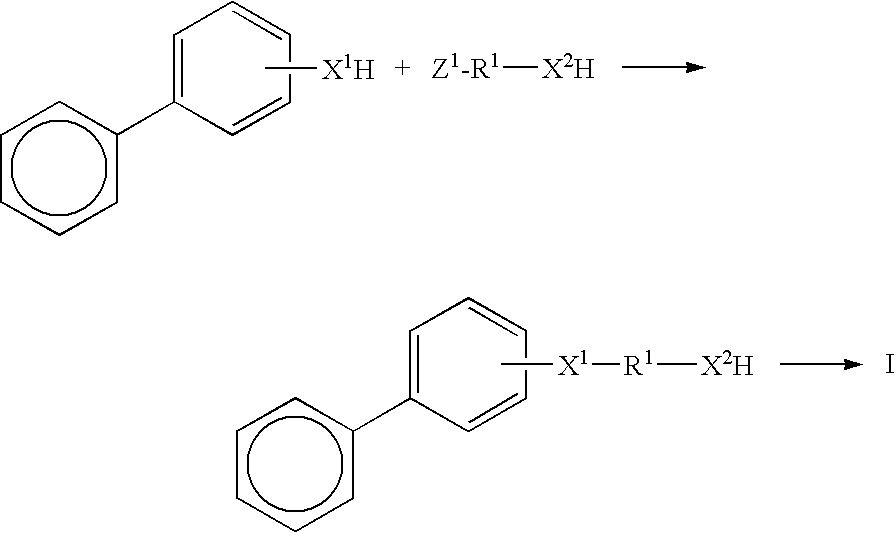High refractive index pressure-sensitive adhesives
a high refractive index, adhesive technology, applied in the direction of adhesive types, organic chemistry, sulfur dyes, etc., can solve the problems of glare and reflectance, and achieve the effect of reducing glare and reflectan
- Summary
- Abstract
- Description
- Claims
- Application Information
AI Technical Summary
Benefits of technology
Problems solved by technology
Method used
Image
Examples
example 1
Preparative Example 1
Synthesis of 6-(Biphenyl-2-yloxy)-hexan-1-ol
[0077]To a two liter three neck round bottom flask was added 2-hydroxy biphenyl (100 g.), water (635 g.), sodium iodide (8.8 g.) and sodium hydroxide (94 g. of 50% in water). This mixture was heated to 100° C. with agitation. To this was added 6-chloro-1-hexanol (160.5 g.) dropwise over about one hour, followed by heating at 100° C. for an additional three hours. Gas Chromatography showed less than 2% residual starting material. The reaction mixture was cooled to room temperature, ethyl acetate (900 g) was added and the aqueous phase was removed. The organic phase was washed with water (500 g. containing 25 g. HCl), followed by a second wash with water (500 g.). The solvent was removed under reduced pressure on a rotary evaporator. The crude product was distilled under vacuum, first removing residual 6-chlorohexanol, then continuing until the pot reaches about 100° C. at 1 mm Hg. 150 g of yellow oil was obtained. GC in...
example 2
Preparative Example 2
Synthesis of Acrylic acid 6-(biphenyl-2-yloxy)-hexyl ester (BPHA):
[0078]To a one liter three neck round bottom flask add 6-(biphenyl-2-yloxy)-hexan-1-ol (145 g), toluene (500 g.), para-toluene sulfonic acid (5.5 g.), acrylic acid (46.4 g.), hydroquinone (0.06 g.) and hydroquinone monomethyl ether (0.06 g.). The mixture was heated to reflux, using a Dean-Stark trap to collect the water azeotrope. After 6 hours, gas chromatography showed g of the homopolymer is −2° C.
preparatory example 3
Synthesis of 8-(biphenyl-2-yloxy)-octan-1-ol
[0079]The compound was prepared using essentially the procedure of Preparatory Example 1 with 2-hydroxy biphenyl (40 g.), water (250 g.), sodium iodide (3.5 g.) and sodium hydroxide (37.6 g. of 50% in water). This mixture was heated to 100° C. with agitation and 8-chloro-1-octanol (77.4 g.) was added. The product was recovered essentially as in Preparatory Example 1.
PUM
| Property | Measurement | Unit |
|---|---|---|
| Fraction | aaaaa | aaaaa |
| Fraction | aaaaa | aaaaa |
| Percent by mass | aaaaa | aaaaa |
Abstract
Description
Claims
Application Information
 Login to View More
Login to View More - R&D
- Intellectual Property
- Life Sciences
- Materials
- Tech Scout
- Unparalleled Data Quality
- Higher Quality Content
- 60% Fewer Hallucinations
Browse by: Latest US Patents, China's latest patents, Technical Efficacy Thesaurus, Application Domain, Technology Topic, Popular Technical Reports.
© 2025 PatSnap. All rights reserved.Legal|Privacy policy|Modern Slavery Act Transparency Statement|Sitemap|About US| Contact US: help@patsnap.com



